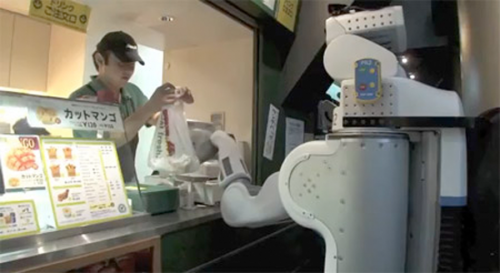
The University of Tokyo and Technische Universität München, uses semantic search to task a PR2 robot with fetching a sandwich. The PR2 has no detailed information on sandwiches, but its database tells it that sandwiches are a type of food, and that food can be found in kitchens and restaurants, its database also has maps and locations, and from that, it figures out where to look. The robot has to figure out how to find and use an elevator to a lower level where a Subway is located.
“Semantic search” is the process of deriving logical conclusions from premises known or assumed to be true. In this example it’s a computerized version of what we humans think of as “common sense.” For example, if someone asks you to bring them a glass without telling you exactly where the glass is, you’re probably smart enough to infer that a glass can be found in cabinets or dishwashers, and cabinets and dishwashers are typically located in a kitchen, so you can go to the kitchen, poke around a bit, and find a glass.
[ willow garage ]








